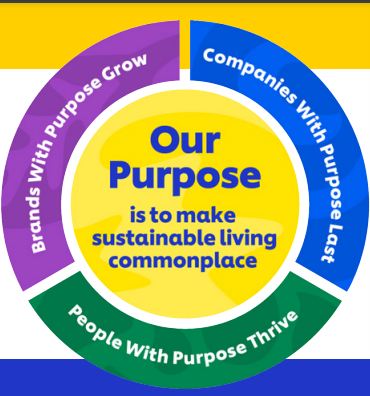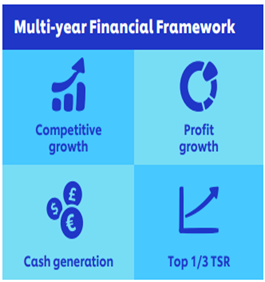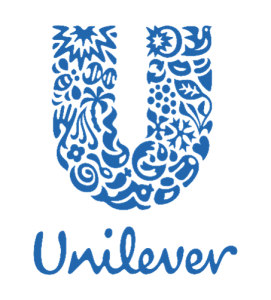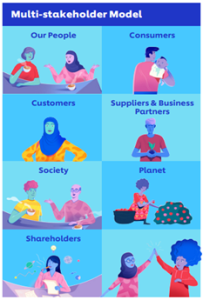BUS7B26 Emphasising the Environment Assignment Sample
Introduction
Considering the global climatic changes achieving sustainability has become a major requirement for organisations operating in the global market. In this regard, companies have taken steps to minimise the carbon footprint and minimise the use of non-renewable energy. Considering this aspect, the following report would analyse and evaluate Unilever and its current sustainability strategies. The report would also identify the challenges the organisation is currently facing in terms of achieving sustainability based on which the report also aims to develop a sustainability strategic plan. Thereafter implementation of the plan and the benefits that the company can achieve by implementing this sustainability strategy would also be discussed in the following report.BUS7B26 Emphasising the Environment Assignment Sample
Company background

Figure 1: Logo of Unilever
(Source: Unilever, 2022)
According to the Unilever (2022), is one of the leading business figures all around the globe. It has been seen that over 3.4 billion people among 190 countries are utilising the products of Unilever in their everyday lives. Unilever has a variety of product ranges based on the consumers’ demands (Unilever, 2022). The company is targeted to achieve more than 20,000 patients with ground-breaking innovations. Patents on products like Comfort, Domestos, Dove, Magnum and many other patent products are in the international market. It has been noted that the global revenue generated by Unilever in the year 2021 is around €52.44 billion (Statista, 2022).
Sustainability strategies
Being a multinational organisation, Unilever has major responsibilities toward the environment and performs sustainable operations in the management system. Unilever focuses on initiating sustainable operations in every aspect of the business (Unilever 2022). The company mainly focuses on the sustainable growth based on the strategies utilised by the management system.


Figure 2: 5 Growth Fundamentals of Unilever
(Source: Unilever, 2022)
Unilever has 5 major strategic actions and choices to make a sustainable future for the business (Unilever, 2022). The first strategy collection of Unilever signifies that the company focuses on developing its portfolio into high growth spaces. Hence, the company takes initiative to develop products that related to skincare, hygiene, prestige beauty, and plant-based or organics foods. The second strategy if the company primarily focuses on purpose and innovation that directly links to improving the health of the planet, contributing to a fair and more socially inclusive world and improving people’s health confidence and well-being (Unilever, 2022). Hence, it includes climate action, protecting and regenerating nature and believing in a waste-free world. Whereas, the initiatives of climate action by the organisation include the zero-emission operation. By the end of 2030, the firm aims to replace fossil-fuel produced carbon with recyclable and reusable carbon in all cleansing and washing product compositions. The third focus is on impactful innovations based on the operations initiated by the company. Whereas, the fourth strategy highlights developing business performance as well as sustainability (Unilever, 2022).



Figure 3: Sustainable frameworks of Unilever
(Source: Unilever, 2022)
Through their Multi-stakeholder Model and Multi-year Financial Framework, Unilever focuses on generating the sales figures to double by the end of 2025, which are based on positive nutrition and can be helpful to humans as well as nature. Therefore, the fees in the final strategy focus on unlocking capacity through agility and digital transformation. Hence, it also helps the organisation in developing the people or workforce through lifelong learning and training for sustainable development. It has also been noted that the company has developed strategies that help in empowering farmers and smallholders to protect and re-generate farm environments for better environmental safety (Unilever, 2022). Unilever also focuses on collecting and forcing more plastics than they use in their products. The company is also initiating programmes that will focus on implementing water stewardship projects in more than a hundred areas or locations around the globe where there is a water shortage.
Challenges faced by the company to attain sustainability
Unilever being one of the largest FMCG companies and having one of the most diversified product portfolios faces several challenges in terms of attaining sustainability. Even though the organisation has worked quite well in terms of ensuring that procurement of its raw materials is done sustainable, specifically vegetables procure from certified farmers. The use of plastics has been one of the significant issues that the company currently faces as almost every product manufactured by Unilever utilises plastic packaging. Even though the organisation states that it is focused on achieving global sustainability, there are no particular framework deviced by the organisation which can help in collecting all this plastic package waste that is left behind after the product is used (Phelan et al. 2022).
The generation of waste due to plastic packaging is also acknowledged by Unilever due to which strategies like reducing the overall rate of the packaging have been initiated, however, this does not reduce plastics that are generated. It has been estimated that approximately 2 billion people use Unilever products on a daily basis which means the organisation has the capacity to generate up to a billion plastic packaging waste almost every month (Lawton, 2022). This means on an annual basis 24 billion plastic packets are thrown as waste at a minimum. Collecting these insurmountable amounts of waste from various areas in the markets in which Unilever operates is a humongous task and is not practically possible. Adding to that the waste that is collected by recycling plants includes the plastic packets of Unilever along with the plastic packaging of other FMCG companies which increases the overall plastic waste on an annual basis (Hattingh, 2021). Therefore, it becomes practical and impossible for the organisation to identify the amount of plastic waste generated and the amount of plastic that has been recycled from this waste.
Adding to that, sustainable practices and guideline that are developed by Unilever are subject to national laws, which Unilever farmers need to follow. This also includes the use of government-approved chemicals and pesticides for the farming process (Pirmoradi and Rostami, 2021). The problem with the government-approved use of pesticides and chemicals is the fact that it is from one government to another. China, the United States, Brazil and Argentina are the countries that are known for using the largest amount of pesticides for farming (Worldometers, 2022). China tops the list with 1,763,000 tons of pesticide use followed by the USA with 407,779 tons (Worldometers, 2022). The differences in pesticide use laws reflect that the sustainability guidelines and practices followed by Unilever farmers are not so effective. For instance, Phorate and Paraquat are both banned by the EU (Donley, 2019). Apart from that, when it comes to countries like China and Brazil it can be seen that these countries have different regulations in terms of the use of pesticides. Syngenta’s thiamethoxam is a highly popular pesticide in the Brazilian market and as of 2018 approximately 10,000 tons of this pesticide were sold in Brazil used for killing bees (Mongabay, 2020). However, Syngenta’s thiamethoxam is an EU banned pesticide which again reflects that pesticide regulations are not an international standard and Unilever’s dependence on national laws and regulatory framework over the use of pesticides makes its sustainable sourcing flawed in nature.
However, Unilever is still accredited for being one of the most sustainable FMCG companies operating in the global market (Lawrence et al. 2019). This is mostly because the sustainability standards present in the global market in the FMCG industry are almost established by Unilever itself therefore the issues present within its supply chain or not and any other does the company face like other FMCG organisations.
Plan for a sustainability strategy
Considering the above issues and challenges that Unilever faces in achieving sustainability through its flawed sustainability standards it would be essential to develop new and more robust strategies.

Figure 4: Plan for sustainability strategy of Unilever
(Source: Taken from the ides of Unilever, 2022)
Reducing plastics and encouraging recycle
As already identified above the biggest challenge that Unilever faces is in terms of reducing waste and achieving recycling capabilities. In this regard, the organisation can implement an engineering strategy which can help them to recover plastic from customers once a particular product has been used (Prado Perez, 2020). The Organisation can provide rewards to customise who returns the plastic packaging of a particular product. For instance, these plastic packages can be printed with a unique code which would reveal a particular price once these are received by the retailers. Therefore, this can allow Unilever to collect the plastic packages from the customers and ensure that they are disposed of and recycled responsibly rather than ending up in dumping grounds and landfills (Yadav and Veettil, 2021).
Sustainable farming standards
As it has already been seen that the sustainable standards that Unilever has adopted and implemented throughout its supply chain are based on the laws and regulations implemented by the country in which the farmers operate it is essential to standardise the overall policy. In this regard, the organisation would need to identify pesticides and chemicals that Unilever farmers can utilise for farming purposes (Anibaldi et at. 2021). The list of chemicals and pesticides needs to be sustainable and naturally occurring in order to minimise chemical top sense from polluting the nearby area as well as the crops that are grown. Moreover, the company can also encourage the farmers to utilise natural pesticides and fertilisers like manure for farming purposes in order to ensure that no chemicals are used in the farming process helping them to achieve overall sustainability.
Implementation of Sustainable strategies
The implementation of the sustainability strategy would require spreading awareness programs throughout the company’s supply chain. It would be necessary for the organisation to communicate with all its existing farmers that are responsible for growing crops for Unilever (Martin, 2018). Apart from that, the organisation would also need to develop an attractive market communication strategy which can help in encouraging customers to submit the plastic packaging of the products to the retailers and in exchange receive the rewards. This market communication strategy needs to be supported by various elements like social media marketing influencers and marketing and celebrity endorsements (Abubakari and Thuranira, 2021). This can allow the organisation to recover the majority of the plastic that is used for the packaging purpose thereby helping them to achieve a higher and more measurable way to recycle the plastic waste that is generated as a result of Unilever and its product packaging.
Perceived benefits
There are several benefits that the company can gain from the help of sustainability strategies that can be attained by Unilever. Primarily the ability to recycle the waste generated by plastic packaging would allow Unilever to achieve a circular economy and thereby help the company minimise a substantial amount of cost linked with packaging. Apart from that, this would also help in achieving the objectives of UN SDG 9, SDG 11 and SDG 12 (Huang et al. 2021). One of the 17 “Sustainable Developmental Goals” established by the “United Nations General Assembly” in 2015, “Sustainable Development Goal 9 (SDG 9)” is about “industry, innovation, and infrastructure.” Building resilient infrastructure, advancing sustainable industry, and encouraging innovation are the three goals of SDG 9. SDG 9 includes eight aims, and twelve indicators track progress. “Outcome targets” are the first five objectives: Increase access to financial services and markets; create sustainable, resilient, and inclusive infrastructures; modernise all sectors of industry and infrastructure; strengthen scientific research; and advance industrial technology. Making cities inclusive, safe, resilient, and sustainable is the stated goal of SDG 11. The 17 SDGs recognise that sustainable development must balance social, economic, and environmental sustainability and that actions in one area will have an impact on results in other areas as well. SDG 11 includes 10 objectives that must be met, and 15 indicators are used to track progress. The seven “outcome targets” are: safe and affordable housing; accessible and sustainable transportation; inclusive and sustainable urbanisation; mitigation of negative effects of natural disasters; mitigation of environmental impacts of cities; and provision of safe and inclusive green and public spaces. “Ensure sustainable consumption and production patterns” is the official phrase for SDG 12. SDG 12 aims to guarantee efficient resource use, increased energy efficiency, sustainable infrastructure, access to essential services, green and dignified employment, and a higher standard of living for everyone. SDG 12 comprises 11 objectives that must be met by 2030 at the latest, and 13 indicators are used to track progress. Implement the 10-Year Framework of Programs on Sustainable Consumption and Production Patterns; achieve sustainable management and efficient use of natural resources; reduce by half the amount of food wasted globally per person at the retail and consumer levels and the amount of food lost along production and supply chains, including post-harvest losses; achieve environmentally sound management of chemicals, and all of these are considered “outcome targets” in the first eight. Achieving the UN SDG goals would also benefit the organisation to emerge as a responsible producer and manufacturer in the global economy. Additionally, the development of a list of Unilever approved pesticides and chemicals would also allow the organisation to ensure that banned chemicals in any part of the world are not used by farmers. This would help in ensuring that the harmful effect of chemicals and banned pesticides don’t affect the quality and safety of crops grown by the farmers (Orhan and Guajardo, 2022). Moreover, the company plans to encourage the farmers to avoid the use of chemicals in the farming process in its entirety and this can help in achieving organic produce. One of the most essential benefits of these would be the generation of high-quality raw materials that are totally produced with the help of sustainable farming methods.
Conclusion
The above report has helped in identifying some of the existing sustainability strategies adopted by Unilever in its global operations. Based On this it can be stated that the strategies and plans adopted by the company are so far some of the most effective and easy to achieve sustainability. However, the report has also identified the major challenges and the flawed system of achieving sustainability and ensuring it within the company’s supply chain management. Based on the impact and presence of these issues the report has developed a sustainability plan that focuses on ways to reduce plastic waste while also ensuring the reduction of banned chemical and fertilizer use by farmers This can be an effective way to gain sustainability while also benefit the community and involved stakeholders.
Reference
Abubakari, M. and Thuranira, B., (2021). The consumer goods sector and the sustainability agenda in Ghana: a review of sustainability commitments. Discover Sustainability, 2(1), pp.1-17.
Anibaldi, R., Rundle-Thiele, S., David, P. and Roemer, C., (2021). Theoretical underpinnings in research investigating barriers for implementing environmentally sustainable farming practices: insights from a systematic literature review. Land, 10(4), p.386.
Donley, N., (2019). The USA lags behind other agricultural nations in banning harmful pesticides. Environmental Health, 18(1), pp.1-12.
Hattingh, M., (2021). Not so fantastic plastic–What the latest research says about plastic pollution in SA environment. Water Wheel, 20(5), pp.23-27.
Huang, R., Nie, Y., Duo, L., Zhang, X., Wu, Z. and Xiong, J., (2021). Construction land suitability assessment in rapid urbanizing cities for promoting the implementation of United Nations sustainable development goals: a case study of Nanchang, China. Environmental Science and Pollution Research, 28(20), pp.25650-25663.
Lawrence, J., Rasche, A. and Kenny, K., (2019). Sustainability as opportunity: Unilever’s sustainable living plan. In Managing Sustainable Business (pp. 435-455). Springer, Dordrecht.
Lawton, G., (2022). Drowning in a sea of plastic. New Scientist, 253(3375), p.26.
Martin, O., (2018). Marketing Influences through Strategic Campaigns and Sustainability.
Mondejar, M.E., Avtar, R., Diaz, H.L.B., Dubey, R.K., Esteban, J., Gómez-Morales, A., Hallam, B., Mbungu, N.T., Okolo, C.C., Prasad, K.A. and She, Q., (2021). Digitalization to achieve sustainable development goals: Steps towards a Smart Green Planet. Science of The Total Environment, 794, p.148539.
Mongabay, (2020). For European chemical giants, Brazil is an open market for toxic pesticides banned at home. [Online]. Available at: <https://news.mongabay.com/2020/09/for-european-chemical-giants-brazil-is-an-open-market-for-toxic-pesticides-banned-at-home/#:~:text=%E2%80%9CSyngenta’s%20thiamethoxam%2C%20as%20well%20as,legal%20battle%2C%E2%80%9D%20Hoinkes%20says> [Accessed on 25 April 2022]
Orhan, C.C. and Guajardo, M., (2022). Analytics in developing countries: Methods, applications, and the impact on the UN Sustainable Development Goals. International Transactions in Operational Research, 29(4), pp.2041-2081.
Phelan, A.A., Meissner, K., Humphrey, J. and Ross, H., (2022). Plastic pollution and packaging: Corporate commitments and actions from the food and beverage sector. Journal of Cleaner Production, 331, p.129827.
Pirmoradi, A. and Rostami, F., (2021). Farmers’ unsustainable behavior: application of the integrative agent-centered (IAC) framework. Environment, Development and Sustainability, pp.1-15.
Prado Perez, S., (2020). Sustainability Discourse in the Fast-Moving Consumer Goods Sector–A comparison between Procter & Gamble and Unilever.
Statista, (2022). Revenue of Unilever Group worldwide from 2007 to 2021. [Online]. Available at: <https://www.statista.com/statistics/269190/global-revenue-of-the-unilever-group-since-2007/#:~:text=In%202021%2C%20the%20global%20revenue,recorded%20in%20the%20previous%20year> [Accessed on 25 April 2022]
Unilever, (2022). Our brands. [Online]. Available at: <https://www.unilever.com/brands/> [Acessed on 30 April 2022]
Unilever, (2022). The Unilever Compass. [Online]. Available at: <https://www.unilever.com/files/8f9a3825-2101-411f-9a31-7e6f176393a4/compass-strategy.pdf> [Accessed on 25 April 2022]
Worldometers, (2022). Pesticide Use by Country. [Online]. Available at: <https://www.worldometers.info/food-agriculture/pesticides-by-country/> [Accessed on 25 April 2022]
Yadav, N. and Veettil, N.M.K., (2021). Developing a comprehensive business case for sustainability: an inductive study. International Journal of Organizational Analysis.

